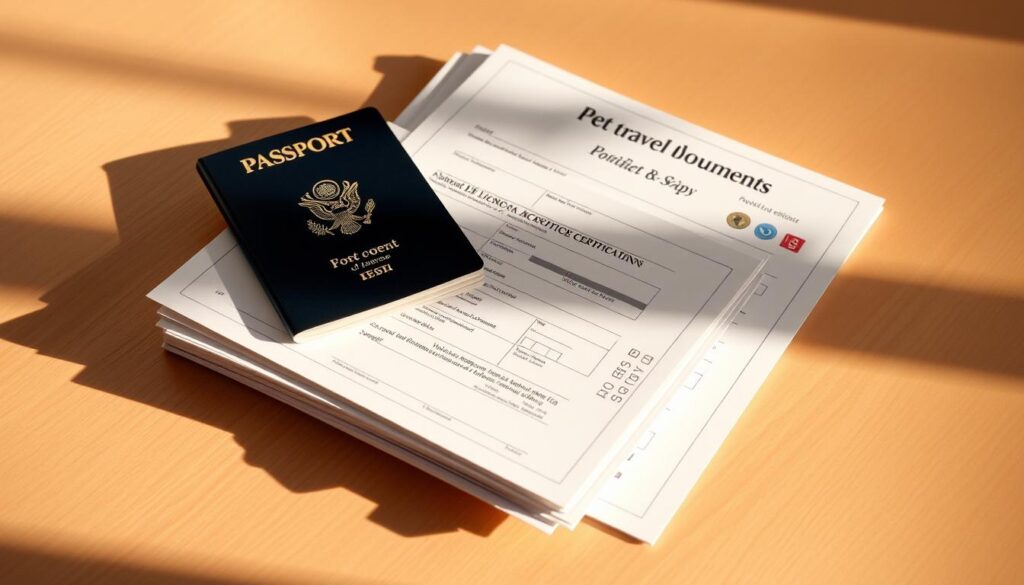Taking your dog on international pet travel can be a wonderful experience. But, it needs careful planning to avoid common errors. You must understand the complexities of traveling overseas with your dog.
There are many factors to consider, from planning and documentation to health and safety. Whether you’re a seasoned pet owner or a first-time traveler with your dog, knowing the mistakes to avoid when taking your dog abroad is key. This ensures a stress-free trip for both you and your pet.
Key Takeaways
- Research the destination country’s pet import regulations.
- Ensure your dog’s vaccinations are up-to-date.
- Obtain a health certificate for your dog.
- Understand the requirements for pet travel documentation.
- Plan ahead for your dog’s travel arrangements.
Planning Your International Pet Adventure
Going on an international trip with your dog needs careful planning. This ensures a smooth journey. Getting everything ready is crucial for a stress-free trip.
Why Proper Preparation Matters
Preparing your dog for travel means knowing what your destination needs. This includes vaccinations, documents, and travel plans. Researching your destination’s pet import rules is key to avoid last-minute issues.
Think about your dog’s special needs, like health conditions or breed-specific rules. Talking to a vet can give you great advice on getting your dog ready for travel.
Common Planning Pitfalls
One big mistake is not planning enough time. Rushing through planning can cause you to miss important details. This includes getting the right documents or making sure your dog’s health certificates are current.
Not looking into pet-friendly places to stay and travel is another mistake. Knowing your options can make your trip less stressful.
Timeline for Successful Pet Travel
Having a timeline for your pet’s travel is essential. Here’s a simple table to help you plan:
| Task | Timeline |
|---|---|
| Research destination requirements | 3 months before travel |
| Obtain health certificates | 1-2 months before travel |
| Book pet-friendly accommodations | 1-2 months before travel |
| Arrange for pet travel | 1 month before travel |

By sticking to this timeline and avoiding common mistakes, you can have a great international pet adventure.
Documentation Disasters: Paperwork Mistakes to Avoid
Traveling abroad with your pet requires careful planning. You need to know the documents needed for a smooth trip. Knowing the right documents and avoiding common mistakes can prevent travel problems.
Essential Documents for International Pet Travel
You’ll need several important documents for international pet travel. These include a health certificate, proof of rabies vaccination, and an export permit. The International Air Transport Association (IATA) has guidelines. But, always check the exact needs for your destination country.

Common Certificate and Form Errors
Mistakes on certificates and forms can cause big delays or even cancel your trip. Make sure all info is correct and matches on every document. For example, your pet’s name and ID must be the same everywhere. A notarized affidavit might be needed for some documents, so check your destination’s needs.
“The most common mistake pet owners make is not allowing enough time to obtain the necessary documentation. It’s crucial to start the process early to avoid last-minute complications.”
Country-Specific Documentation Requirements
Each country has its own rules for pet travel documents. For example, some need a special permit or certification. It’s important to research what your destination requires. Here’s a table with key documents needed for popular places:
| Country | Required Documents | Specific Requirements |
|---|---|---|
| United Kingdom | Pet Passport, Microchip, Rabies Vaccination | Must enter through an approved travel point |
| Australia | Export Permit, Health Certificate, Microchip | Quarantine requirements apply |
| United States | Health Certificate, Rabies Vaccination, Import Permit (for some countries) | Varies by state and country of origin |
Knowing these requirements can help avoid problems and make your trip smoother for you and your pet.
Health and Vaccination Oversights
When you take your dog abroad, health and vaccination issues can be big problems. It’s very important to prepare well before you go. This means more than just a quick vet visit.
Required Vaccinations for International Travel
Different countries have different rules for dog vaccinations. For example, a rabies shot is often needed. But, the timing of this shot is very important.

Timing Mistakes with Health Certificates
A health certificate is usually needed before you travel, usually within 10 days. Missing this deadline can delay or even cancel your trip. It’s important to plan ahead.
Pre-Travel Veterinary Check Importance
A pre-travel vet check is more than just getting a health certificate. It’s a chance to make sure your dog is ready for travel. The vet can give advice on health checks for pet travel and what precautions you need.
“The health of your dog should be your top priority when traveling internationally.”
By focusing on these health and vaccination details, you can make your trip better for both you and your dog. Remember, dog travel tips always stress the importance of preparation and research.
Transportation Troubles: Carrier and Travel Mode Errors
Choosing the right travel plans is key for a smooth trip with your dog. Transportation mistakes can cause a lot of discomfort or even safety risks for your pet. Picking the right pet carrier and knowing airline rules can make a big difference.

Choosing the Wrong Pet Carrier
The pet carrier is your dog’s home during travel. The wrong one can stress them out. A good carrier should be well-ventilated, sturdy, and comfy. Make sure to measure your dog right and pick a carrier that lets them stand, turn, and lie down.
Pet travel experts say, “A carrier that’s too small can stress and discomfort your pet.” It’s also key to make sure the carrier meets IATA standards for flying.
Airline-Specific Pet Policy Misunderstandings
Airline pet policies differ a lot. Not understanding these can cause last-minute changes or denied boarding. It’s vital to research and know your airline’s specific needs, like the carrier type, health papers, and extra fees.
- Check the airline’s pet travel policy well in advance.
- Understand the differences between carrying your pet in-cabin versus checking them as baggage.
- Be aware of any restricted breeds or sizes.
Alternative Transportation Considerations
While flying is quick, it’s not the only way. Thinking about other ways like trains or cars can be better for pets. These options offer more flexibility and less stress for your dog.
A seasoned pet traveler says, “Sometimes, traveling by car or train is better. It lets you take breaks and enjoy a relaxed trip.”
Mistakes to Avoid When Taking Your Dog Abroad: Destination Research
It’s key to research your destination to avoid surprises when traveling with your dog internationally. A well-prepared pet owner can make sure the trip is smooth and fun for both of you.

Breed-Specific Restrictions by Country
Some countries have laws that limit or ban certain dog breeds. For example, Australia and New Zealand have strict rules about bringing in some breeds. Always check the breed laws of your destination country to avoid problems when you arrive.
Climate and Environmental Hazards
Different places have different climates and environments that can be risky for your dog. For example, hot and humid places can cause heatstroke, while cold places may need special gear for your dog. Knowing the local climate and potential dangers will help you get your dog ready.
Key considerations include:
- Temperature extremes
- Humidity levels
- Presence of local diseases and parasites
Local Pet Laws and Etiquette
It’s important to know the local pet laws and how people view dogs. Some places have strict leash laws, while others have rules for dog waste. Knowing these rules and respecting local customs will make your trip better and less stressful.
By doing your homework on the destination, you can avoid and prepare for any issues. This ensures a safe and fun trip for you and your dog.
Accommodation and Lodging Blunders
Finding the right place to stay is key to your dog’s comfort and safety when traveling abroad. It’s important to pick your lodging wisely to avoid any issues that could harm your pet.
Pet-Friendly Accommodation Verification Errors
Many people make the mistake of not checking if a place is really pet-friendly. Some places might say they allow pets but have hidden rules. Always confirm the pet policy with the hotel or manager and read reviews from other pet owners.
Hidden Fees and Restrictions
Even if a place says it’s pet-friendly, there could be hidden costs or rules. Some places might charge extra for pets or have specific rules. Always ask about any extra fees or rules before you book.
Comparison of Pet Fees at Various Hotels
| Hotel | Pet Fee | Pet Size Restrictions |
|---|---|---|
| Hotel A | $50/night | Under 20kg |
| Hotel B | $100/stay | No restrictions |
| Hotel C | Free | Under 10kg |
Making Your Temporary Home Dog-Safe
After booking your stay, make sure it’s safe for your dog. Look for hazards like toxic stuff, electrical cords, and sharp objects. Secure dangerous areas and bring your dog’s favorite things to make them feel at home.
By avoiding these common mistakes, you can make your trip better for both you and your dog. Always do your research, ask the right questions, and take steps to keep your pet safe in your temporary home.
Dietary Disasters: Feeding and Nutrition Mistakes
Traveling internationally with your dog means you must plan their diet carefully. Their food is as crucial as it is at home. Ignoring this can harm their health.
Food Import Restrictions
Every country has its own rules for pet food imports. Some ban certain ingredients or need special permits. For example, the European Union has strict rules on meat and dairy imports. It’s vital to check these rules before traveling to avoid trouble.
Water Safety Concerns
Tap water quality varies worldwide. Some water may have harmful contaminants. “Always give your dog bottled or filtered water to keep them safe,” a vet advises. You can also use water purification tablets or a portable filter.
Managing Diet Changes Abroad
Changing your dog’s diet suddenly can upset their stomach. To avoid this, pack enough of their regular food if it’s not available where you’re going. If you must change foods, do it slowly to ease digestive problems.
By paying attention to these dietary needs, you can keep your dog healthy and happy on your trip.
Safety and Security Slip-ups
Traveling with your dog internationally is more than just booking a flight. It’s about safety and security. You need to plan and prepare carefully to keep your dog safe while abroad.
ID and Microchip Errors
Having the right ID is crucial for your dog’s safety. Microchip them and make sure their tags are current. This helps find them if they get lost while traveling.
Key considerations for ID and microchipping:
- Ensure the microchip is ISO-compliant (15-digit)
- Register the microchip with your contact information
- Update your contact information if it changes
Leash and Control Requirements
Keeping your dog under control is essential. Use the right leashes and harnesses. Also, follow local leash laws.
Tips for leash and control:
- Use a comfortable, escape-proof harness
- Familiarize yourself with local leash laws and regulations
- Keep your dog on a leash in unfamiliar areas
Emergency Preparedness Failures
Being ready for emergencies is key. Have a pet first-aid kit and know local vets. Also, have a plan for disasters or emergencies.
| Emergency Preparedness Item | Description |
|---|---|
| Pet First-Aid Kit | Include supplies for wound care, bandages, and basic medical needs |
| Local Veterinary Services | Research and list local vets and pet hospitals |
| Emergency Plan | Have a plan for natural disasters, including evacuation routes and pet-friendly shelters |
By focusing on these safety and security steps, you can lower the risks of traveling abroad with your dog.
Return Journey Considerations Often Forgotten
When you’re bringing your dog back home, planning is key. The excitement of your trip may be fading, but focus on the return journey. This ensures a smooth transition for you and your pet.
Re-entry Requirements for Your Home Country
Before heading back, find out what you need to bring your dog home. You’ll need updated health certificates and proof of vaccinations. Make sure you have all the necessary paperwork to avoid any last-minute problems.
Post-Travel Health Checks
Book a vet visit for your dog after the trip. This is crucial if you’ve been to places with diseases not found at home. A vet can spot any health issues early.
Quarantine Possibilities and Preparation
Learn about quarantine rules for your country. Some places require pets to quarantine if certain rules aren’t followed. Get your dog used to their carrier and reduce stress in case of quarantine.
Here are some key things to consider for a smooth return:
- Check the re-entry requirements for your home country.
- Book a vet visit after traveling.
- Understand quarantine rules and prepare your dog.
Conclusion: Ensuring a Smooth International Adventure with Your Canine Companion
When you’re ready to take your dog abroad, knowing what to avoid is crucial. This ensures a stress-free trip for both you and your pet.
Understanding the basics of international pet travel is key. This includes documents, health checks, and safe transport. This guide has given you important tips to make pet travel easier.
With the right planning, you can steer clear of problems. This includes knowing what your destination needs and preparing for the return trip. Being well-informed is the secret to a successful journey.
By following these tips and avoiding common mistakes, you and your dog can have a great time. You’ll make memories that last a lifetime.







